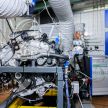After a multi-million-pound investment, Lotus has revealed the latest upgrades to its Hethel headquarters, which will help grow its Lotus Engineering division. This will help expand the division’s portfolio of consultancy service and its client base, while complementing the Lotus Cars business as it prepares to deliver a new range of performance cars.
Among the improvements made include an all-new electric drive unit (EDU) test cell, which will allow Lotus engineers to test EV powertrains as well as supporting auxiliary systems. The test and development cells of internal combustion engines also received an upgrade, along with its propulsion prototype build workshop and vehicle emissions lab.
Outside of these areas, the company’s 3.54-km test track, where race and road car development has taken place since 1966, also gets a revamp. “We see huge potential to put Lotus Engineering right at the cutting edge of automotive innovation, further building on our core competencies as well as increasing our capability in growth areas,” said Matt Windle, executive director of Engineering at Lotus.
“An example is electrification; the challenges around weight reduction and improved dynamics are a major factor in the quest for more efficient electric vehicles, and those link back directly to the Lotus core values. What we continue to learn on the Lotus Evija all-electric hypercar programme creates knowledge and experience which we can use to help other businesses,” he added.
These latest improvements are in addition to the preparation of an all-new factory, which will be be responsible for an upcoming Lotus model starting next year. This is in addition to the new assembly hall dedicated to the Evija – both will begin operations producing new Lotus cars during 2021.
Lotus’ rejuvenation strategy under Geely’s wing has seen a slew of new projects being announced. Aside from the Evija, there’s also the Lambda SUV planned along with other models. Geely has a 51% controlling stake in the British carmaker, with 49% owned by Etika Automotive, a Malaysian conglomerate.
Looking to sell your car? Sell it with Carro.













Lotus Geely Volvo > all
Lotus is doing so well now. Last time under Proton, it was losing money every year for 10 years berturut turut.
Now suddenly, when Geely took over, it is making big bucks.
Well done China, well done Geely.
Sorry to burst your bubble Kunta but it was under Proton Management that Lotus finally turned a profit in their decades of existence.
Last time we overpaid the Lotus CEO so much of money but no results. Every month, his gaji was in the millions.
Now, China took over, we see so much of results.
This is why we need more CHina intevention into our companies here in Malaysia to do better and increase productivity
Flopped for the past decade with dinasaur tech, abandoned by Proton, ready to reborn?
Congratulations to British. Geely China saved England
I am the author of 5 patents regarding an innovative, new generation of ecological clean internal combustion engine, and a new timing system. I would like to introduce two main patents, and also the complete concept elaboration of all five. I am looking for a contact with a decision person, or department dealing with cooperation with inventors from outside the company. I will be very grateful if you find the time to get acquainted my ideas. I hope you will find these solutions interesting and they will be worth implementing.
Yours sincerely, Jacek Majewski
Benefits of using a patent 235520: It is a completely new conception of ecologically clean, two-stroke internal combustion engine for clean fuel, without oil admixture. (It is not a minor improvement of existing four stroke engine).
1. Two stroke engine for pure fuel (oil free fuel).
2. Elimination of two unecessary strokes.
3. Twice the power and torque compared to a four-stroke engine.
4. Less mechanical stress despite double increased power.
5. Higher efficiency.
6. High torque even at low engine speed.
7. Lower vibrations and much smoother engine operation.
8. Ventylation of the combustion chamber with air, (not air-fuel mixture).
9. Lower fuel consumption.
10. Reduced engine idle speed.to 200-300 RPM.
11. Smooth engine operation, even at 200-300 RPM.
12. A cost-free and failure-free way to supercharge the engine.
13. Small dimensions of the engine.
14. Longer engine life.
15. Easy and low cost of implementing a patent based on proven and
known sub-assemlys.
16. Lower production costs.
Benefits of using a patent 232440: It is innovative timing system for this two-stroke engine and also for use In all four-stroke engines.
1. More favorable, more „square” work characteristics.
2. Elimination of valve springs.
3. Elimination of the need to adjust valve clearances.
4. Elimination of hydraulic regulator of valve clearances.
5. Much shorter valves.
6. Better valve guidance, despite their smaller length.
7. Better valve lubrication.
8. Less loss of engine power to the valve drive.
9. Less mechanical stress.
10. Much longer life of toothed belt or valve driver chain.
11. Smaller dimensions of the timing system.
12. Lower production costs.
13. Eliminate of valve springs is the basis for the development of electronic
valve control.